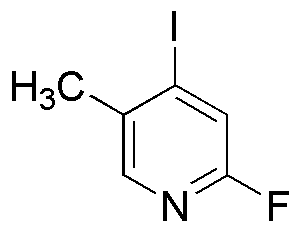2-Fluoro-4-iodo-5-methylpyridine is widely utilized in research focused on:
- Pharmaceutical Development: This compound serves as an important intermediate in the synthesis of various pharmaceuticals, particularly in the development of new drugs targeting neurological disorders.
- Agricultural Chemicals: It is used in the formulation of agrochemicals, enhancing the efficacy of pesticides and herbicides, which helps in improving crop yields.
- Material Science: The compound is explored for its potential in creating advanced materials, including polymers and coatings that require specific chemical properties.
- Analytical Chemistry: It acts as a reagent in analytical methods, aiding in the detection and quantification of other chemical substances in complex mixtures.
- Research in Organic Synthesis: This chemical is valuable in organic synthesis, allowing researchers to create complex molecules more efficiently compared to traditional methods.
General Information
Properties
Safety and Regulations
Applications
2-Fluoro-4-iodo-5-methylpyridine is widely utilized in research focused on:
- Pharmaceutical Development: This compound serves as an important intermediate in the synthesis of various pharmaceuticals, particularly in the development of new drugs targeting neurological disorders.
- Agricultural Chemicals: It is used in the formulation of agrochemicals, enhancing the efficacy of pesticides and herbicides, which helps in improving crop yields.
- Material Science: The compound is explored for its potential in creating advanced materials, including polymers and coatings that require specific chemical properties.
- Analytical Chemistry: It acts as a reagent in analytical methods, aiding in the detection and quantification of other chemical substances in complex mixtures.
- Research in Organic Synthesis: This chemical is valuable in organic synthesis, allowing researchers to create complex molecules more efficiently compared to traditional methods.
Documents
Safety Data Sheets (SDS)
The SDS provides comprehensive safety information on handling, storage, and disposal of the product.
Product Specification (PS)
The PS provides a comprehensive breakdown of the product’s properties, including chemical composition, physical state, purity, and storage requirements. It also details acceptable quality ranges and the product's intended applications.
Certificates of Analysis (COA)
Search for Certificates of Analysis (COA) by entering the products Lot Number. Lot and Batch Numbers can be found on a product’s label following the words ‘Lot’ or ‘Batch’.
Numéro de catalogue
Numéro de lot/série
Certificates Of Origin (COO)
This COO confirms the country where the product was manufactured, and also details the materials and components used in it and whether it is derived from natural, synthetic, or other specific sources. This certificate may be required for customs, trade, and regulatory compliance.
Numéro de catalogue
Numéro de lot/série
Safety Data Sheets (SDS)
The SDS provides comprehensive safety information on handling, storage, and disposal of the product.
DownloadProduct Specification (PS)
The PS provides a comprehensive breakdown of the product’s properties, including chemical composition, physical state, purity, and storage requirements. It also details acceptable quality ranges and the product's intended applications.
DownloadCertificates of Analysis (COA)
Search for Certificates of Analysis (COA) by entering the products Lot Number. Lot and Batch Numbers can be found on a product’s label following the words ‘Lot’ or ‘Batch’.
Numéro de catalogue
Numéro de lot/série
Certificates Of Origin (COO)
This COO confirms the country where the product was manufactured, and also details the materials and components used in it and whether it is derived from natural, synthetic, or other specific sources. This certificate may be required for customs, trade, and regulatory compliance.


